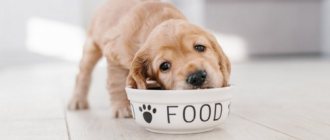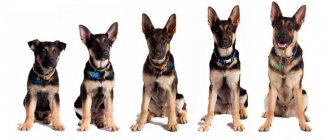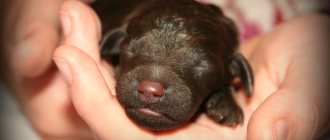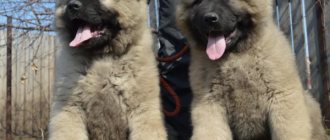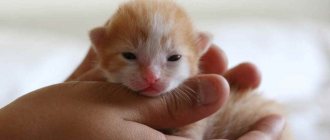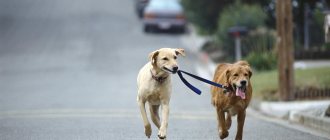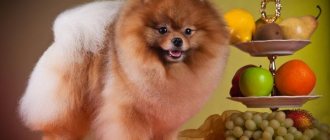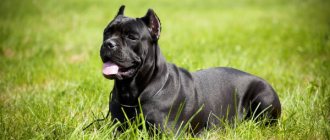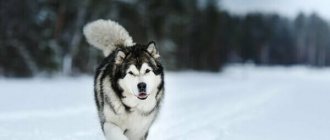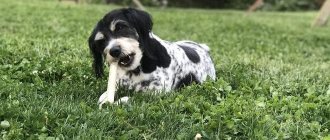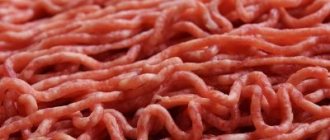At 2 months of age, your puppy is ready to leave his mother and brothers and join your family. Your focus should be on your puppy's basic needs to eat, drink, sleep, play and eliminate. Around this time, your puppy also becomes interested in everything around him, so this is the best time to start teaching your puppy everything he needs to know!
The new surroundings of your home and all the new sights and smells that come with it are a little scary for him. Reduce your puppy's stress and fear by spending plenty of time together. The more time you spend with your 2 month old puppy, the stronger your bond will be for life. Let's find out how to care for 2 month old puppies.
At what age is it better to adopt a puppy?
As a rule, puppies begin to be sent to new families at the age of 1.5-2.5 months, and breeders can keep dogs of small or dwarf breeds for up to 3-3.5 months.
If you are offered to adopt a puppy at the age of 1 month, it is better not to do this, giving the baby the opportunity to grow up in his own family for another month.
Regardless of what age you adopted the puppy, at two months, three or four months, try from the first day to establish the right relationship with him, which is usually called good contact. This will allow him to develop affection for you, obedience, devotion, and subsequently love. To do this you need:
- always treat your pet calmly,
- feed him on time, walk him, comb him - that is, take care of him,
- regularly engage with him, combining games and initial training.
Try not to let any troubles in life affect your interactions with your puppy. Dogs sense the mood of their owner very subtly and react to it accordingly.
Puppy care
There's a new addition to your family. How to organize care for a puppy from the first days. What further care will be required, basic measures.
First adaptation measures.
Caring for a puppy begins from the first minutes of its arrival in its new home. Remember that moving a puppy to a new home is always stressful. Loss of mother, brothers, sisters and familiar environment. If possible, for a more comfortable adaptation, you can ask for a toy from the old house, or maybe a bedding that will smell like “mother.” Also, find out what the puppy’s daily routine was like, what food the breeder fed him, in order to recreate the baby’s usual habitat for the first time. Don't forget to give your puppy enough time so that he doesn't get sad. Games are an effective method; after jumping to your heart's content, your baby will sleep soundly. Next - how to properly organize the care of a puppy.
Adaptation of a puppy in an apartment.
Puppy care and safety measures.
Keep the apartment clean; there should be no things or objects scattered on the floor that could harm the puppy. Because everything found will be regarded as a toy. Be careful with wires from electrical appliances; they should be raised as high as possible. Make sure there are no sharp objects on the floor. Gender itself is also important, especially for large breed puppies. It shouldn't be slippery. Usually rugs and carpets are used for this purpose.
Organization of a vacation spot.
If you don't want your pet to sleep in your bed, you need to explain this to your puppy right away. Otherwise, it will be very difficult to wean yourself off it later. Therefore, the puppy should have its own comfortable place. One where he will rest and where he cannot be disturbed. It is important to choose a place not on the aisle or near the battery. After all, proper care for a puppy presupposes the mandatory organization of proper rest. Especially with the beginning of intensive dog training.
If you plan to engage in exhibitions, or travel with your pet, you should consider the cage option under “place”. Don’t be afraid of it; if you do the right things, it will become a wonderful home for your baby, where he can rest comfortably and recuperate.
Caring for a puppy involves proper nutrition.
Currently, there is a lot of debate about choosing the right feeding for a puppy. Choosing natural food or dry food is not always easy. This is also not helped by the many feeding menus and wide range of food in pet stores. But still, it is always individual. Any feeding has its pros and cons. Therefore, everyone chooses what suits their needs and prices.
For the first two weeks, you should feed the puppy what the breeder fed it. Even if you don't like this food. Changing nutrition is also stressful for a small organism. After all, the composition of the feed is different, the production is different. And the enzymes for digesting them are the same. And combined with the stress of changing places and losing your mother, this will cause great discomfort. Therefore, the transition to a new diet should be gradual.
Hygienic care.
After the puppy has become a little accustomed, you can accustom him to hygienic manipulations. This will be systematic care for the dog throughout the rest of its life. This includes grooming the coat, nails, teeth, eyes, ears and bathing. More specific care measures are prescribed by the veterinarian according to indications.
And, of course, this is toilet training. It is worth asking the breeder how this was organized for him. Everything may be different in a new home. There is a widespread recommendation that the puppy must immediately be taught to do its business on a specially laid out diaper. But, firstly, this option was originally conceived only for sick and weakened puppies, or at least those in quarantine. It can only be used if walking is impossible (the breeder does not have the first vaccination). Secondly, it is much more difficult to wean oneself off a diaper than to accustom one to one! In reality, it’s easier to wait 1-2 weeks until walking begins. It’s better to go around with a rag, wiping up puddles, with some non-aggressive detergent so that there is no smell left. This will be easier than retraining your pet later.
Well, once you start walking, you can accustom your puppy to the outdoor toilet in a few days. To do this, from the very first days you need to take it outside every 2-3 hours. After sleep, after feeding, if there are signs of anxiety, the puppy begins to sniff the floor and run in circles. Such moments should not be missed. Very soon your pet will learn that doing all his business is much more comfortable and convenient outside - the necessary habit begins to form.
You can also use incentives for successfully completed hygiene trips. It is also important to catch the moment when the puppy begins to ask: whining, acting restless, running up to the door.
If a puppy is accustomed to a diaper, there is no need to ask for it; it is accustomed to “following” the smell. If there is no diaper, the smell of previous activities is destroyed, the puppy restlessly searches for this smell and its behavior is typical and noticeable. At this moment, you can pick it up and take it outside.
In subsequent days, the intervals between hygienic walks gradually increase.
Wool.
It all depends on your dog's coat type. Use either a brush for short-haired breeds, or a slicker brush and comb for long-haired breeds. You should also teach it gradually, start with feeling during games and communication. Then you can comb it in parts, gradually moving on to general combing. Long-haired dogs should be brushed daily. Breeds with curly hair are plucked as they become overgrown and before shows (this is best done by a groomer). Caring for a short-haired puppy is only necessary during the molting period. This is also daily brushing.
Claws.
A very difficult component of care. This procedure must be encouraged every time with something tasty. And also accustom it gradually. First, simply introduce the puppy to the nail clipper. Then, taking the paw, bring the nail clipper to each claw a couple of times. After each presentation, treat your baby with a tasty treat. And only when he gets used to it, you can trim his claws, rewarding him with a treat each time.
Nail trimming scheme
The frequency of haircuts depends on physical activity and the time of year. In summer and outdoors, the claws, as a rule, wear down well. But in winter this process is slower. Therefore, haircut occurs approximately once a week, as it grows.
Caring for a puppy: trimming nails.
Teeth cleaning.
Not used in puppies. But caring for an elite class dog requires this before exhibitions. Therefore, such puppies also need to be taught this manipulation. This is usually done after active games, when the puppy is already tired. For other dogs, brushing is a good substitute for feeding dry food.
Eyes and ears.
The eyes, as a rule, do not require special care, but be sure to monitor them daily so that there are no accumulations, discharge, or tearing. This is usually due to infection, allergy, or injury, requiring a visit to the veterinarian.
Ears should be checked daily. Cleaning is carried out in the presence of discharge, contamination - as necessary. Use cotton swabs with lotions to clean the ears, according to the attached instructions. This is especially true for breeds with floppy ears, pressed to the head, as they have more frequent ear infections. Regular puppy care will not be sufficient if the pet periodically shakes its ears restlessly and often tries to scratch them with its paw. This is also a reason to contact a veterinarian and take additional therapeutic measures.
Swimming and walking.
Caring for a puppy also includes bathing. In general, dogs are usually bathed 2-3 times a year. Therefore, gradual accustoming to water allows you to avoid stress when bathing in the future. So, if your baby grows up in the warm season, it is useful to introduce him to bodies of water in a playful way.
The duration of walks is appropriate for age and is determined individually, but the lack of time for a walk will certainly affect the dog’s health and its behavior at home. If you do not want the furniture at home to be an object for sharpening teeth, walks should be sufficient in time, accompanied by active games and lead to some fatigue for the dog upon return.
Deworming, disinsection and disinfestation are preventive measures.
Caring for your dog also includes preventing and getting rid of internal and external parasites. The presence of fleas and worms leads to a decrease in the body's immune system, which can contribute to other diseases. What is a tick bite and possible consequences - probably everyone knows this. For preventive purposes, pets are treated once every three months. The means for this are varied; each one is consulted in veterinary clinics or specialized pharmacies. But forgetting about this is unacceptable. Deworming is also required before vaccinations.
Toys.
For each age, toys are needed that correspond to the physiological and psychological status of the dog. As a rule, it is recommended to purchase silicone-based toys, as they will not damage baby needle teeth. Do not buy hard toys, they can injure baby teeth. And this can lead to the formation of an incorrect dog bite. Games and toys are an important component of your dog's future training.
These measures make up the entire care of the puppy. Excessive care is also not good, so you need to know when to stop. Give the dog boiled water, heat food, treat toys, cover the dog’s bed with pillows, do not walk in bad weather “so as not to catch a cold,” etc. – will only lead to the development of a “refined” dog, unable to adapt to changes in the external environment, and therefore more susceptible to many diseases. Therefore, caring for a puppy requires a reasonable approach.
Cynologist instructor E.L. Brazheeva
Problems that arise as the puppy grows
Problems that can arise during the growth period of puppies of any breed are mostly associated with improper feeding. The amount of food should be constantly measured in relatively small portions to avoid overeating. Obesity in dogs puts a lot of strain on the heart and circulation. It happens that puppies and young dogs are exposed to unnecessary excessive stress on weak ligaments and joints. The consequence of this can be diseases associated with the paws and joints. With proper nutrition, the puppy should actively play, run, and explore the territory several times a day. Excessively tiring walks of several hours should be avoided in the first year of life. If your dog becomes unwell, contact your dog's breeder or veterinarian immediately.
Prevention of parasites
The following drugs are recommended for use:
- Milbemax
- Dosalid
- Trianthelm
- Kanikvantel plus
- Cestal plus
Preparations with pyrantel (Dosalid, Cestal plus, Trianthelm) have less toxicity, since pyrantel is poorly soluble in water and poorly absorbed from the gastrointestinal tract. Trianthelm is one of the safest medications that can be effectively used to prevent worms.
Milbemax has a number of restrictions on use; for example, it is not recommended for shelties, collies and bobtails. Kanikquantel plus has low toxicity to the dog’s body and, in the absence of allergies to the components, can be freely used as a therapeutic or prophylactic agent.
Prepare places to sleep and eat
The place to sleep should be soft and comfortable. It is best to place it where the floor is easy to clean, since at first the puppy will not have time to go to the toilet outside. In addition, there should be no drafts in this place so that the pet does not get sick.
The puppy will need two bowls: one for food and one for water. Metal ones are best, as they do not break and are easy to clean. In order not to spoil the dog’s posture, it is better to place the bowls on a special stand with adjustable height. The dishes should be placed at the level of the pet's elbows. You should always feed him in the same place, where no one will disturb him: for example, in the corner of the kitchen or hallway, but not at the entrance to the home.
Health
From 8 to 16 weeks you will need to visit your veterinarian regularly for vaccinations, deworming and routine checkups. During this period of time, isolate your pet from other animals and avoid visiting public places. Only after your doctor's approval will you be allowed to go for walks, visit the park, and play with other dogs (under close supervision, of course).
The last vaccination (against rabies) is given at 4 months, and after it you do not need to visit a doctor until the dog reaches adulthood. At the final visit, be sure to ask any questions you have.
If you are planning to spay or neuter your dog, this is usually done between five and six months of age. It all depends on the breed and size and is decided individually.
Aspects of education
Sometimes, with the best of intentions, new owners do too much to relieve the puppy from the stress of separation from its mother. This applies to being with the baby every minute, feeding in places not intended for eating, constantly being carried in arms and other things.
You should understand: the puppy will grow up, but the habits will remain.
The older the dog gets, the less affection his pranks cause, and over time, the dog still begins to instill good manners. Late socialization and learning the rules of behavior in the house are painful for animals and traumatic for the psyche.
Prioritization or who is boss in the house
In order for the puppy to learn from the first days the arrangements in the “pack”, where the leader will be a person, you need to adhere to some rules:
- Both the dog and the owner have the right to privacy. You cannot spend all your free time with the puppy - the puppy must be able to occupy itself. After playing with your pet, you should leave him alone and go about your business. You can defiantly ignore him for a while: the baby will calm down and stop bothering you.
- You need to teach your dog to stay home alone. You need to do this from the first day, going out the door for a few minutes. It is important that the puppy sees this happening and does not sleep during this time. Over time, the “care” intervals are increased, but no more than an hour in the first few days. During the period when the baby is left alone, he should be well-fed and play enough.
- From the first days, the puppy needs to arrange a place to rest and eat: he must learn to understand that the apartment is divided into certain zones, each with its own functionality. If the feeding place is chosen in the kitchen, it is wrong to expect that the dog will not subsequently go there whenever he wants.
- The dog eats after the owner. This is a very important rule, which subsequently eliminates many behavior problems, especially in “serious” dog breeds. The dog must see that the person (leader) is eating. This is the order of the pack among wild relatives, and domestic animals are no different genetically from them.
- The owner goes up the doors, openings, and stairs first. The puppy will not learn this rule from the first day, but from the moment training begins, you need to remember it, since it is included in the list of priorities.
Such aspects of education do not violate the norms of morality and morality, and the dog will not love its owner less if it learns them. Raising a puppy does not mean its humiliation or infringement of the animal's rights. It is aimed at comfortable coexistence between humans and dogs in society and is designed to ensure, in particular, the safety of people living with the pet.
Place training
Your puppy should have a place where he can feel safe and rest without worrying about someone stepping on him or kicking him out of the way. As a rule, dogs like special beds that are sold in pet stores, but you can also easily design them yourself. Small breeds of dogs are provided with houses, while very large dogs often do without bedding at all. The lounger is arranged in a non-accessible area of the apartment, away from drafts.
In addition to the rest function, the place for the dog has another purpose: it is a certain point where the puppy can be sent if he is in the way or gets naughty. Determining a place for a dog is very important: it increases self-esteem, since a smart owner respects not only his freedom, but also his dog’s personal space.
Teaching a puppy the “place” command is not difficult. At the moment when he has had enough of playing and has practically fallen asleep, he needs to be taken to the mat and told “place!” The command is also repeated during the puppy’s attempts to explore the bed. Fixing the location with a voice will be imprinted in the dog’s memory over time. You can accustom him to his place from 2 months.
Important: it is wrong to try to strengthen the team with food by placing treats on the bedding. The dog is not fed where it sleeps; conflicting commands can confuse the pet.
Toys
Like all children, puppies should have their own toys. Their presence is very significant:
- They protect things and objects in the apartment from destruction, because teething requires a product that can relieve the itching, and often without the opportunity to chew a tasty toy, puppies spoil clothes and furniture.
- Toys help brighten up the puppy's lonely hours when the owners are not at home.
- This is a great way to keep your pet in good physical shape and a means of training the mind: many modern toys are created specifically for this purpose.
Products that are dangerous for a puppy. What should you not give to an animal?
- Sweets. Sweet foods should not be present in your dog's diet. An exception is fruits and dried fruits. Any sweet foods (fruit, chocolate, marmalade) should be avoided in the dog’s diet;
- Flour products. Products made from rye, wheat flour or any other types of flour are contraindicated for dogs. The consequences of feeding such foods will be bloating, colic and indigestion. You should not follow the lead of a pet who is begging you for a piece of a bun; it will be dangerous to his health;
- Tea and coffee;
- Mushrooms;
- Spices;
- Nuts.
Puppy 3 months – teeth change
Typically, complex teething does not begin until four months of age, but some puppies may begin teething before three months of age. However, even when the baby teeth are still firmly in place, the puppy behaves with everyone around him as if they were members of his canine family, so he plays, also in ritual games of “who will kill whom” or “how to hunt the victim.”
Our delicate, hairless limbs usually do not tolerate these manifestations of his interest. We walk around scratched by our puppy - experienced caregivers treat these noble scars condescendingly, but new owners get injured. I think we have a very dominant (or aggressive, mean, abusive - delete unnecessary) dog. If he bites now and does not respect us, then when he grows up, he will bite everyone in turn!
No panic. Such a small dog probably doesn't think about dominance and solving problems using its teeth. He uses them to understand the world. Like every small child, he loves to play, and dog play has a lot in common with the behavior of an adult - that is, the little one tries to imitate adults by hunting and fighting. He plucks his sharp baby teeth without malice - that's what nature dictates.
© shutterstock
This is still such a delicate creature, we cannot discipline her too much or show our displeasure. It’s worth trying - when the puppy grabs us too much - give him a toy instead of a hand.
Mongrel dog: maintenance and care at home
A mongrel is a dog that does not belong to any specific breed. It happened as a result of mixing different breeds. It is believed that such dogs have better health than purebred dogs, since in the process of evolution they developed independently, without any human intervention. At the same time, the strongest dogs survived. But since mongrels are usually homeless, this lifestyle poses a certain threat to them in terms of acquiring various diseases.
A mongrel dog is not purebred, which is why it is often called a yard dog. The description of her appearance is always unique. Some dogs may be similar in appearance to one breed or another. Very often, a mongrel resembles a shepherd or a cross between a shepherd and a mongrel. Often there are outbred dogs that look like terriers. Much less common are small long-haired mestizos. Yard dogs can have both floppy ears and erect ones, which cannot be said about purebred dogs.
3rd month of a dog’s life – training
What a wonderful age: three-month-old puppies are still so attached to the idea that older and smarter ones are his ideal guardians that he hardly tries to distance himself without trying to establish contact. Moreover, he considers us a great authority, so if he is called, especially in a cheerful tone, announcing various attractions, he will lose his paws, rushing to the call. Let's take advantage of this by rewarding the dog for each such willing behavior with a game or a treat - the period of rebellion will still come, but it is worth making sure that the puppy has the best opportunity to come to the first call.
In addition, the puppy is stuck in a house where the number of distractions is limited. It's time to teach him his name.
What to feed a mongrel puppy - choosing the type of diet
When choosing what to feed your mongrel puppy, you need to decide on the type of diet:
- Natural.
- Industrial.
- Mixed.
Each type of feeding has advantages and disadvantages. In addition, switching from natural food to food (or vice versa) is stressful for the body. It is advisable to immediately decide what type of diet will be convenient for the dog.
Natural diet
Natural diet for a mongrel puppy, this is a menu of:
- Fresh and prepared foods.
- Meat porridge and treats.
- Exclusively fresh products - raw food diet.
The first two options have been tested and approved by many years of experience from both veterinarians and dog owners. Raw food diet is a relatively new method of creating a menu for a dog. With a reasonable approach to switching to fresh food and balancing products, it guarantees the health of the gastrointestinal tract and teeth.
Benefits of a natural diet:
- Cheaper than feed.
- You can control the freshness and quality of products.
- You can regulate your caloric intake.
- You can pamper your dog with a variety of foods.
- If a food allergy occurs, it is quite possible to create a “reasonably priced” diet.
Disadvantages of a natural diet:
- Natural food spoils quickly, so dog food needs to be prepared regularly.
- It is necessary to regularly add vitamins and microelements to food.
A mongrel puppy can be fed with natural products from the age of one month. Until the age of one, the pet needs to be accustomed to healthy foods - vegetables, fruits, herbs, while simultaneously expanding the diet.
Ready-made feed
Ready-made food is an excellent alternative for owners who do not have enough time to cook or buy fresh food for their pet. Diets vary in type:
- Dry (granules).
- Semi-moist (pieces with gravy).
- Moist (pate or paste).
- Treats.
Wet and semi-moist foods are suitable for puppies. For adult dogs, the diet consists of dry and wet food. Treats are used periodically - for training, reward, teeth cleaning, etc.
The main criterion when choosing food is quality or class:
- Economy
- Premium
- Super premium.
- Holistic.
The higher the class of food, the more expensive it is. Premium food is a segment of average price and quality, but such diets are suitable only for healthy and active dogs. Ready-made feeds are divided into lines according to their intended purpose. For healthy, young dogs, everyday food is suitable. If your pet has special needs, you need to choose food from specialized lines:
- Supportive.
- Preventive.
- Medicinal.
- For exhausted animals.
Advantages:
- No need to cook.
- It’s easy to choose the daily norm.
- They are stored longer - you can buy them for several months and leave them in an automatic feeder.
Disadvantages of ready-made feeds:
- More expensive than natural ones and often lower in quality.
- Good, popular food is counterfeited.
- Complete vitamin supplements are found only in expensive foods.
You can start feeding your mongrel puppy canned food from the age of one month. At 3–4 months, soaked dry food is introduced into the diet. After a complete change of teeth, you can take high-quality dry food as the basis of the diet.
Mixed diet
A mixed diet is a menu of ready-made food and natural products, sometimes even meat porridge. The advantage of a mixed diet is convenience - what you eat is what you feed. There are many more disadvantages:
- Dysbacteriosis due to incomplete digestion of food.
- Avitaminosis.
- Gaining excess weight due to excess carbohydrates.
Statistically, a mixed type of diet is most often chosen for mongrels, considering them omnivores and large dogs that are difficult to feed.
Puppies up to 4–5 months of age are physically unable to digest food of different textures. If there is an urgent need to mix the diet, give preference to high-quality canned food or soak the granules in warm water.
Punishment
Many people are interested in: “What can and what can’t you punish a little puppy for?” At this age it is better to do without punishment. They definitely will not give the required result, and the nervous system and mutual understanding will be damaged. We strongly recommend that you learn the list of things you should absolutely not punish a 3-month-old puppy for.
- Heaps and puddles at home. At this early age, the daily routine has not yet been adjusted, and one has not yet learned to tolerate it.
- Damaged material assets and things. You cannot blame the puppy for damage. Most likely, you didn’t remove it, forgot it, or left it in a visible place. All valuables should be kept out of reach. And if you have exposed wires and cables, take care of cleaning them up immediately. This is a favorite toy of small puppies, and it is also unsafe.
- Running and active games. At this age, puppies are distinguished by their mobility. They have more than enough energy. It is better to walk your pet more often.
- Biting off wallpaper and pieces of walls. If your dog regularly chews or licks walls, you should consult a doctor. He may be lacking minerals.
- Playing with the hands and feet of family members. This habit is characteristic only of small puppies, and as they grow older, it goes away. Usually such games become uninteresting to him after 4 months.
Do you have a special situation?
Our specialists met with everyone. They share their experiences in detail in our online school!
more details
Sanitation.
When purchasing a puppy from dogs of a breeder who is a member of the club, the buyer is always sure that his pet has received all the necessary vaccinations and is healthy. This cannot be said about a dog from the street, and therefore, first of all, it must be taken to a veterinary hospital for an examination. There the doctor will give an opinion on her state of health based on the examination. If the dog is found healthy, all medical procedures will include deworming, flea and tick treatment, and vaccinations.
It should be noted that dogs taken from the street are healthier than their purebred relatives and do not have genetic diseases.
After visiting the veterinary clinic, the mongrel should be washed well with a special anti-flea shampoo, ears and eyes should be cleaned and, if necessary, claws trimmed. It is better to carry out the last procedure not independently, but also in a veterinary clinic.
Bad habits of puppies and ways to eliminate them
There are a lot of options for unwanted behavior in puppies. Let's look at the three most common of them.
1) Beggar dog. This puppy always hangs around the dinner table when the owners are getting ready to eat. The baby whines, looks pitifully straight into the eyes and tries in every possible way to get a tasty morsel. This behavior is formed after the dog has been treated to food from the owner’s table at least once. Feed your pet before you sit down for lunch or dinner, never indulge his whims and do not give him anything from the table.
2) Beaver dog. Sometimes puppies consider table legs, armrests of sofas and chairs, and wires to be edible. The habit of chewing furniture and other objects not only harms the owner’s belongings, but can also be dangerous for the pet itself. Try treating your puppy's favorite places with a special spray. You can buy this repellent at any pet store.
3) Food from the ground outside tastes better! Often, puppy owners are faced with the problem of their pet picking up food while walking outside. This behavior can pose a threat to the health and life of the dog. During a walk, the dog should be muzzled and on a leash, this will protect it from dangerous “treats”. Also teach your pet the “Fu” command.
Provide security
Before you bring your puppy home, you need to take some safety precautions to prevent him from harming himself:
- Hide all electrical wires, because the pet will study the world around him, including with the help of his teeth;
- Remove breakable objects higher that the puppy can drop or knock over;
- Hide bottles with household chemicals;
- Make a trash can inaccessible to him or purchase a heavy and tall bin.
If necessary, you can even fence off part of the home with a partition so that the puppy can only move around a safe area.
Is it possible to mix natural and industrial food?
Attention! Never mix commercially produced food with natural food.
Some owners add industrial food to their puppy’s regular food “to make them full.” Such nutrition is absolutely wrong for the animal and can cause serious harm to its health. The fact is that to digest industrial and natural food in the animal’s body, different enzymes are required. Such a diet can lead to serious problems of the digestive system, intestinal disorders, and allergies.
Buy toys
Puppies grow and develop, they are full of energy, and it is best to channel it in the right direction so that furniture, shoes and other items not intended for play do not suffer. To avoid unpleasant surprises, you should buy your pet more toys.
The main thing is that they are safe: in particular, that small parts cannot be bitten off of them, which can be a choking hazard. Some animals are delighted with toys with squeaks, but be prepared to put such items away every night where the puppy cannot reach them. Due to his age, he will not yet understand why he should not play or make noise at night.
